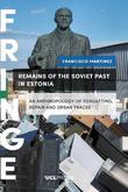Explore

Remains of the Soviet Past in Estonia
Francisco Martinez
2018
0 Ungluers have
Faved this Work
Login to Fave
What happens to legacies that do not find any continuation? In Estonia, a new generation that does not remember the socialist era and is open to global influences has grown up. As a result, the impact of the Soviet memory in people’s conventional values is losing its effective power, opening new opportunities for repair and revaluation of the past.
Francisco Martinez brings together a number of sites of interest to explore the vanquishing of the Soviet legacy in Estonia: the railway bazaar in Tallinn where concepts such as ‘market’ and ‘employment’ take on distinctly different meanings from their Western use; Linnahall, a grandiose venue, whose Soviet heritage now poses diffi cult questions of how to present the building’s history; Tallinn’s cityscape, where the social, spatial and temporal co-evolution of the city can be viewed and debated; Narva, a city that marks the border between the Russian Federation, NATO and the European Union, and represents a place of continual negotiation of belonging; and the new Estonian National Museum in Raadi, an area on the outskirts of Tartu, that has been turned into a memory field.
This book is included in DOAB.
Why read this book? Have your say.
You must be logged in to comment.
Rights Information
Are you the author or publisher of this work? If so, you can claim it as yours by registering as an Unglue.it rights holder.Downloads
This work has been downloaded 28 times via unglue.it ebook links.
- 28 - pdf (None) at Google Books.
Keywords
- anthropology
- Communism
- Eastern Europe
- Estonia
- European History
- History
- Humanities
- Linnahall
- Marxism & Communism
- Narva
- Political Ideologies
- Politics & government
- Regional & national history
- Russians
- Social & cultural anthropology, ethnography
- Society & Social Sciences
- Sociology & anthropology
- soviet
- Tallinn
- thema EDItEUR::J Society and Social Sciences::JH Sociology and anthropology
- thema EDItEUR::J Society and Social Sciences::JH Sociology and anthropology::JHM Anthropology
- thema EDItEUR::J Society and Social Sciences::JH Sociology and anthropology::JHM Anthropology::JHMC Social and cultural anthropology
- thema EDItEUR::J Society and Social Sciences::JP Politics and government::JPF Political ideologies and movements::JPFC Far-left political ideologies and movements
- thema EDItEUR::N History and Archaeology::NH History::NHD European history
Links
DOI: 10.14324/111.9781787353534Editions

